| Article ID | Journal | Published Year | Pages | File Type |
|---|---|---|---|---|
| 10668695 | Surface and Coatings Technology | 2010 | 6 Pages |
Abstract
It was found that the deposition rate increased as a function of time to a peak, and then decreased to a steady-state value. The peak occurred sooner using the 9 mm anode than with the 30 mm anode. The peak deposition rate increased and the peak time decreased with I. The steady-state deposition rate was larger for Zn (~ 2 μm/min) than for Al cathodes (~ 1 μm/min) at I = 225 A and L = 110 mm. The arc voltage for Al was ~ 20-22 V and for Zn it was 11 V. The deposition rate peak appeared due to MPs evaporating from the hot anode, where they had initially condensed during the conventional arc stage when the anode was still cold. This effect was significant with low melting temperature Al and Zn cathodes, and negligible with Cu and Ti cathodes studied previously.
Related Topics
Physical Sciences and Engineering
Materials Science
Nanotechnology
Authors
I.I. Beilis, Y. Koulik, R.L. Boxman, D. Arbilly,
